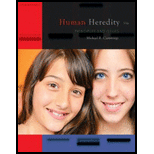
Concept explainers
Antibiotics and Protein Synthesis
Antibiotics are molecules produced by microorganisms as defense mechanisms. The most effective antibiotics work by interfering with essential biochemical or reproductive processes. Many antibiotics block or disrupt one or more stages in protein synthesis. Some of these are mentioned here.
Tetracyclines are a family of chemically related compounds used to treat several types of bacterial infections. Tetracyclines interfere with the initiation of translation. The tetracycline molecule attaches to the small ribosomal subunit and prevents binding of the tRNA anticodon during initiation. Both eukaryotic and prokaryotic ribosomes are sensitive to the action of tetracycline, but this antibiotic cannot pass through the plasma membrane of eukaryotic cells. Because tetracycline can enter bacterial cells to inhibit protein synthesis, it will stop bacterial growth, helping the immune system fight the infection.
Streptomycin is used in hospitals to treat serious bacterial infections. It binds to the small ribosomal subunit but does not prevent initiation or elongation; however, it does affect the efficiency of protein synthesis. Binding of streptomycin changes the way mRNA codons interact with the tRNA. As a result, incorrect amino acids are incorporated into the growing polypeptide chain, producing nonfunctional proteins. In addition, streptomycin causes the ribosome to randomly fall off the mRNA, preventing the synthesis of complete proteins.
Puromycin is not used clinically but has played an important role in studying the mechanism of protein synthesis in the research laboratory. The puromycin molecule is the same size and shape as a tRNA/amino acid complex. When puromycin enters the ribosome, it can be incorporated into a growing polypeptide chain, stopping further synthesis because no peptide bond can be formed between puromycin and an amino acid, causing the shortened polypeptide to fall off the ribosome.
Chloramphenicol was one of the first broadspectrum antibiotics introduced. Eukaryotic cells are resistant to its actions, and it was widely used to treat bacterial infections. However, its use is limited to external applications and serious infections. Chloramphenicol destroys cells in the bone marrow, the source of all blood cells. In bacteria, this antibiotic binds to the large ribosomal subunit and inhibits the formation of peptide bonds. Another antibiotic, erythromycin, also binds to the large ribosomal subunit and inhibits the movement of ribosomes along the mRNA.
Almost every step of protein synthesis can be inhibited by one antibiotic or another. Work on designing new synthetic antibiotics to fight infections is based on our knowledge of how the

Questions
Why are antibiotics ineffective in treating the common cold and other virus infections?
Want to see the full answer?
Check out a sample textbook solution
Chapter 9 Solutions
Human Heredity: Principles and Issues (MindTap Course List)
- Can I get this answered with the colors and what type of connection was formed? Hydrophobic, ionic, or hydrogen.arrow_forwardCan I please get this answered with the colors and how the R group is suppose to be set up. Thanksarrow_forwardfa How many different gametes, f₂ phenotypes and f₂ genotypes can potentially be produced from individuals of the following genotypes? 1) AaBb i) AaBB 11) AABSC- AA Bb Cc Dd EE Cal bsm nortubaarrow_forward
- C MasteringHealth MasteringNu × session.healthandnutrition-mastering.pearson.com/myct/itemView?assignment ProblemID=17396416&attemptNo=1&offset=prevarrow_forward10. Your instructor will give you 2 amino acids during the activity session (video 2-7. A. First color all the polar and non-polar covalent bonds in the R groups of your 2 amino acids using the same colors as in #7. Do not color the bonds in the backbone of each amino acid. B. Next, color where all the hydrogen bonds, hydrophobic interactions and ionic bonds could occur in the R group of each amino acid. Use the same colors as in #7. Do not color the bonds in the backbone of each amino acid. C. Position the two amino acids on the page below in an orientation where the two R groups could bond together. Once you are satisfied, staple or tape the amino acids in place and label the bond that you formed between the two R groups. - Polar covalent Bond - Red - Non polar Covalent boND- yellow - Ionic BonD - PINK Hydrogen Bonn - Purple Hydrophobic interaction-green O=C-N H I. H HO H =O CH2 C-C-N HICK H HO H CH2 OH H₂N C = Oarrow_forwardFind the dental formula and enter it in the following format: I3/3 C1/1 P4/4 M2/3 = 42 (this is not the correct number, just the correct format) Please be aware: the upper jaw is intact (all teeth are present). The bottom jaw/mandible is not intact. The front teeth should include 6 total rectangular teeth (3 on each side) and 2 total large triangular teeth (1 on each side).arrow_forward12. Calculate the area of a circle which has a radius of 1200 μm. Give your answer in mm² in scientific notation with the correct number of significant figures.arrow_forwardDescribe the image quality of the B.megaterium at 1000X before adding oil? What does adding oil do to the quality of the image?arrow_forwardWhich of the follwowing cells from this lab do you expect to have a nucleus and why or why not? Ceratium, Bacillus megaterium and Cheek epithelial cells?arrow_forward14. If you determine there to be debris on your ocular lens, explain what is the best way to clean it off without damaging the lens?arrow_forward11. Write a simple formula for converting mm to μm when the number of mm's is known. Use the variable X to represent the number of mm's in your formula.arrow_forward13. When a smear containing cells is dried, the cells shrink due to the loss of water. What technique could you use to visualize and measure living cells without heat-fixing them? Hint: you did this technique in part I.arrow_forwardarrow_back_iosSEE MORE QUESTIONSarrow_forward_ios
 Human Heredity: Principles and Issues (MindTap Co...BiologyISBN:9781305251052Author:Michael CummingsPublisher:Cengage Learning
Human Heredity: Principles and Issues (MindTap Co...BiologyISBN:9781305251052Author:Michael CummingsPublisher:Cengage Learning Biology (MindTap Course List)BiologyISBN:9781337392938Author:Eldra Solomon, Charles Martin, Diana W. Martin, Linda R. BergPublisher:Cengage Learning
Biology (MindTap Course List)BiologyISBN:9781337392938Author:Eldra Solomon, Charles Martin, Diana W. Martin, Linda R. BergPublisher:Cengage Learning Biology 2eBiologyISBN:9781947172517Author:Matthew Douglas, Jung Choi, Mary Ann ClarkPublisher:OpenStax
Biology 2eBiologyISBN:9781947172517Author:Matthew Douglas, Jung Choi, Mary Ann ClarkPublisher:OpenStax Biology Today and Tomorrow without Physiology (Mi...BiologyISBN:9781305117396Author:Cecie Starr, Christine Evers, Lisa StarrPublisher:Cengage Learning
Biology Today and Tomorrow without Physiology (Mi...BiologyISBN:9781305117396Author:Cecie Starr, Christine Evers, Lisa StarrPublisher:Cengage Learning Biology: The Dynamic Science (MindTap Course List)BiologyISBN:9781305389892Author:Peter J. Russell, Paul E. Hertz, Beverly McMillanPublisher:Cengage Learning
Biology: The Dynamic Science (MindTap Course List)BiologyISBN:9781305389892Author:Peter J. Russell, Paul E. Hertz, Beverly McMillanPublisher:Cengage Learning Concepts of BiologyBiologyISBN:9781938168116Author:Samantha Fowler, Rebecca Roush, James WisePublisher:OpenStax College
Concepts of BiologyBiologyISBN:9781938168116Author:Samantha Fowler, Rebecca Roush, James WisePublisher:OpenStax College





